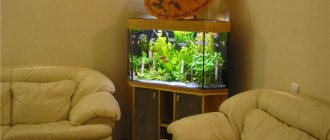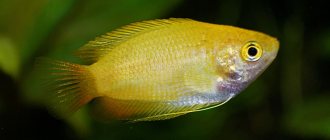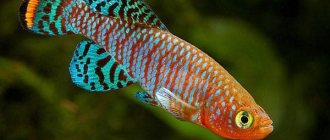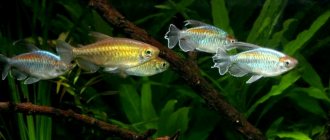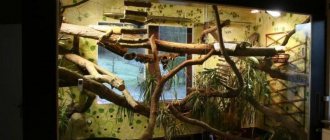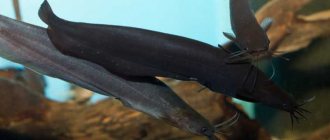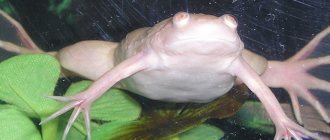Terrarium art is a fashionable hobby that will not only help you decorate your home, but also get to know the world of wildlife better. Nowadays terrariums are becoming more popular than aquariums. You can take pictures with a spider or snake, watch them grow and molt, watch how a turtle or lizard hunts and eats. Cleaning a terrarium at home is also easier than changing the water in the aquarium. Therefore, it is not surprising that more and more people are striving to decorate their interiors with terrariums.
Terrarium in a jar for a snail
Terrarium for a spider in the living room of a country house
Basilisk: keeping at home
This reptile is the most popular to keep in the house. It should be borne in mind that individuals taken from the wild do not take root well in an unnatural environment for them. Therefore, for home breeding and keeping, it is better to take lizards bred in an incubator. Living in a terrarium, the reptile's color changed. It turned bluish. The lizard will be sad alone. Therefore, these reptiles are kept in pairs.
Nutrition should be balanced. The basis of the diet is vegetation. Lizards eat sprouted wheat, carrots, bananas, apples and other fruits well. But they also need other food: small rodents, lizards. Animals lay their eggs in a nest, the bottom of which is covered with sand and wet moss. The eggs are taken from the female and raised for 30 days in an incubator.
How to feed?
The lizard needs to be given food when it is in a state of activity. If there are several pets, each is fed separately. When the reptile is showing normal activity, drinking as usual, but eating little, there is no need to worry. She also has fasting days. Young lizards are fed using tweezers, while adults eat on their own from a plate. In summer, pets are fed 3 times a day, and in winter - only two. They feed on:
- spiders, worms, crickets, bird eggs, small mammals;
- for them you can prepare a special mixture of grated carrots and chopped meat into small pieces, taken in equal proportions;
- you can give cottage cheese, egg shells, calcium tablets, chalk (sources of calcium) and vitamins;
- it is allowed to eat salads, spinach, parsley, plantain, dandelion, clover;
- They like to feast on cabbage, cucumbers, zucchini, potatoes and fruits, for example, pears, apples, grapes.
Purchasing an iguana
You can buy an iguana at a pet store or order it online, which is not difficult these days. However, when buying a pet, you should approach the issue of choice correctly, we will talk about this further.
What type of iguana should you choose as a pet?
If you want to purchase an exotic pet, you can choose one of the following types:
- the green iguana has a long green body, individuals are classic inhabitants of pet stores;
- the Madagascar variety has a pleasant gray color with yellow spots;
- The collared iguana has the brightest coloring among all varieties, which is what attracts buyers when choosing an animal.
The presented individuals easily adapt to living at home, and also have a beautiful appearance and unpretentious character.
What to look for when buying an iguana?
An important criterion when choosing a pet is its health, so you should learn to correctly distinguish healthy from sick individuals. In order for an iguana to live a long time and delight you with its presence, you should buy a healthy individual and properly care for it.
First of all, when purchasing, you need to examine the pet and evaluate the following signs:
- The skin should not have wounds or scratches, it should be clean and free of dirt. The body should not show bruises, injuries, or contusions.
- The abdominal area should not be covered in sand or feces.
- The anus is normally dry and clean, without bowel movements.
- The animal can walk on all legs, all limbs are the same size without changes.
- There should be no mucus coming out of your nose.
- The eyes should be clean and clear, without any cloudiness or dirt.
- The general condition of the iguana is normally active, it constantly moves, and has a good appetite.
- The oral cavity is normally pink in color.
Breeding bearded dragons
During the break between breeding, lizards of different sexes are kept in separate cages, since being near a male can cause severe stress in the female. When purchasing a different gender, if a sibling already lives in the apartment, they should be allowed to spend at least half an hour next to each other: the animals should get comfortable and not be afraid of each other. The breeding process of bearded dragons consists of several sequential steps:
- Placing the female and male in one container. It is necessary to monitor the behavior of the female agama: if she sits still and tries not to be active, then she is removed because she is not ready to mate. The attempt is repeated after 2-3 days for 10-15 minutes.
- Marriage games. When ready to mate, the male agama inflates its hood and moves quickly. The female should respond by chasing him and raising her front legs.
- Rapprochement. A male bearded dragon approaches his partner from the side or from behind, lightly biting her on the neck. The mating process itself lasts 3-5 minutes.
- Conception. The female retains her partner’s sperm for a long time, so she can lay eggs even 2-3 weeks after he is deposited.
How to determine the gender of a bearded dragon?
These animals are characterized by dimorphism - differences in primary sexual characteristics. It is called the hemipenis - the copulatory organ of lizards and snakes. When relaxed, it hides in the cloaca, so the sex of the animal must be determined by eye and by palpation. People who breed bearded dragons know that the male of this species has two penises, but only one of them is used during mating. After mating, one of the penises is retracted back into the cloaca. In a female lizard, you can feel only one hemipenis under the tail.
DIY florarium: step-by-step master class
Mini-greenhouses look stylish and expensive, but they can be created with your own hands
Often gardeners prefer to make all flower arrangements themselves, but creating terrariums has a number of features, so we will consider this process step by step, paying special attention to the technical features of microclimate formation
To work on decorative home gardens you will need:
- glass vessels of various shapes;
- houseplants;
- pebbles, charcoal, soil with added sand;
- additional decorations.
Small stones, rounded with sea waves, are poured onto the bottom of the container, followed by a layer of charcoal to prevent the development of mold and bacteria, and the work is completed by adding soil. If the neck is narrow, in order to avoid contaminant particles from getting on the walls of the vessel, you can roll a tube out of paper and lower it into the container so that a couple of centimeters remain to the bottom. You need to pour all the layers very carefully through this tube and funnel.
The soil must be watered, after which you can begin planting plants, the roots of which are first thoroughly cleaned of the soil. If the florarium is created in a bottle with a narrow neck, you can use tweezers, plastic spoons or forks with elongated handles (for example, sushi chopsticks or pencils).
The areas of soil that remain open after planting are covered with sand, small pebbles or planted with moss; in the latter case, you need to put a special mixture for mosses, which grow better in acidic soils. Only at the very end of the work should you move on to decoration.
Of course, it’s easier to make a garden yourself, which can be placed on window sills, open shelves, chests of drawers or coffee tables, but if possible, you can also install a wall-mounted plant terrarium.
Source materials
Making a terrarium with your own hands is a rather painstaking and time-consuming task, but as a result you can get a product of the appropriate size and adapted for a certain type of exotic pet. A system made to individual dimensions will be easy to install in a specific niche or any other opening.
Silicate and organic glass are best suited for making a terrarium.
The benefits of using such material are as follows:
- difficult to break;
- the plexiglass box retains heat well;
- plexiglass fragments rarely have sharp edges;
- organic glass is easy to process.
Don’t forget to prepare the source material
. But this material also has certain disadvantages:
- If the finished product is not used correctly, scratches appear on the surface of the walls. For this reason, you should wash the glass only with a soft flannel cloth or gauze. It is unacceptable to use hard sponges, scraping devices or chemicals with fine-grained fillers.
- When exposed to sunlight, the plane of plexiglass loses its transparency and begins to become cloudy and fade.
Only those residents who do not have claws can live in a terrarium made of such material:
- spiders;
- snakes;
- Achatina.
For animals with claws (lizards and turtles), the main box should be made of other materials.
In addition to glass, you will need to purchase:
- plastic corners;
- durable aluminum mesh for the ventilation system;
- plastic profiles for making a doorway in two sizes (their depth must correspond to the thickness of the material intended for making doors).
In this video you will learn how to make a terrarium:
Selection of organic glass
Of course, you can make a terrarium for your pets from ordinary glass, but this process is much more complicated and requires experience and skills from the master. Glass is quite fragile, cracks and breaks easily.
To choose plexiglass suitable for making a terrarium, it is enough to know that it comes in two types:
- casting;
- extrusion
Molded plexiglass causes fewer complaints from consumers, since it does not become cloudy as quickly as extruded glass. Some types of molded plexiglass perfectly transmit ultraviolet rays and do not deteriorate when exposed to sunlight.
There are 2 types of plexiglass
For this reason, such material is more expensive than extrusion analogues. Sheets with a thickness of more than 0.5 cm are suitable for making a terrarium.
Choosing the right adhesive
The modern chemical industry offers consumers a wide range of different adhesive compositions. In order to choose the right adhesive, you need to consider several principles.
The glue should be:
- harmless to the health of humans and their pets (do not form toxic chemical compounds and do not emit unpleasant odors upon contact with food, water and animal excrement);
- durable;
- waterproof.
Any silicone sealant intended for gluing terrariums or aquariums is ideal for this purpose.
Equipment and tools
Before you begin, you should prepare the following tools:
- glass cutter;
- sandpaper;
- ruler;
- glass marker;
- well sharpened knife;
- a rectangular load with a smooth flat surface;
- double-sided tape;
- well sharpened scissors.
During the work, you will need rags to remove the remaining adhesive from the surface of the glass and hands.
There are a number of requirements for glue
Making terrariums for a hamster with your own hands
As a general rule, the arrangement of a habitat for rodents occurs in accordance with the listed criteria. Volume and width 40×50, maybe less, it all depends on the number of representatives of this species
Particular attention should be paid to the technique of cleaning waste products and eliminating odors.
For rats, it is important to place toys for active recreation: carousels and swings, many passages and places where they can chew something. For the hamster it is worth installing drinking bowls and holes in which he will store provisions
These animals are lazy and have a good appetite.
It is worth installing drinking bowls and holes for the hamster in which he will store provisions. These animals are distinguished by laziness and good appetite.
For mice, warmth, ventilation and active pastime are important components of health. Interesting houses and tiered structures will decorate the life of rodents.
Shelters
The reptile looks for a place where it feels safe. Usually there are at least two nooks: in the warm and cold zones. This is a pile of flat stones, branches, a clay pot, ceramics. They use boxes, boxes with a hole, hanging hollows, and long pieces of bark.
You can buy ready-made grottoes for the terrarium. Artificial structures weigh less than natural ones. Shelters with one transparent or removable wall have appeared on sale for observing secretive individuals. To organize a wet shelter, sphagnum moss is placed on the floor in the box. It is moistened periodically - it stores water for a long time.
Ventilation of the terrarium
The creation of a terrarium should be approached as responsibly as possible; first, important aspects and nuances of this difficult matter should be considered. There is no need to remake the product from the aquarium, since iguanas are specific animals. You will definitely need a lid, it will prevent your pet from escaping, and you can also attach lighting devices to it. The best design for this would be a front glass with the ability to open; this feature allows cleaning to be carried out several times faster than with vertical loading.
The terrarium should be located in a quiet place; the ideal option would be an office-library or bedroom. At the same time, there should be no foreign pets in the room, especially dogs. Lizards can still get along with cats, but four-legged furry creatures can’t stand iguanas, so they don’t go into the room where the terrarium is located.
It is important to isolate the reptile from sources of radiation and noise, for example, a TV or stereo system. The iguana loves a lot of free space, the size of the terrarium should be 2000x2000x1000, but if it is an individual, then these dimensions of the house need to be increased
The terrarium should be located in a quiet place
It should be understood that the terrarium must also be durable; it is better to choose steel material, and this option will be ideal for any interior. In the corner, the lizard should have its own climate and conditions that will resemble its natural habitat. To do this, you must maintain the correct temperature, humidity and even guarantee a constant light output. A pet requires constant care and attention, so you can’t leave home for a long time, and if we’re talking about several days, then these chores should be entrusted to a trusted person.
Not all finishing materials are suitable for iguanas; first of all, you cannot attach gypsum panels and use plaster with gypsum; you can get by with wallpaper or cement plaster. At night, the temperature should be 20-21 degrees Celsius; in winter, you additionally need to spray the animal’s house, since batteries can dry out the surrounding air. During the day, the temperature should be much higher, so you will have to adjust the heater daily or purchase an automatic model. There is no need to buy a product that produces a loud sound when operating, since iguanas cannot tolerate this.
Ventilation should be done exclusively natural; without high-quality air circulation, the animal will begin to develop various diseases, and ultimately this will lead to death. Simple holes in the top cover will not be enough; the best option would be a ventilation slot, which must be covered with a strong mesh. As a rule, such a slot with a mesh is located at the top of the terrarium and at the bottom; in the latter case, its level is slightly lower than the pool. A lamp is installed in the lid on the mesh; when it is turned on, a natural draft will arise, due to which excessive moisture will instantly evaporate, which will be good for the normal functioning of the reptile.
Make sure the terrarium is well ventilated
Place for food and food
The feeder must be placed in a warm part, and it must be stable. Otherwise, the turtle will definitely knock it over and then kick it long and hard. For example, a light plastic cat feeder will not work; it is better to use a small but heavy ceramic plate for feeding and dig it a little into the ground.
The dishes should not have sharp corners or surfaces that can cause cuts. The same recommendations can be given for drinking bowls. In many pet stores you can purchase a special feeder and water bowl for reptiles.
It is better to organize the feeding area on a flat, smooth surface, such as ceramic tiles or a piece of linoleum. After eating, the reptile usually goes straight to the toilet, and this “tablecloth” can be easily and immediately cleaned.
The usual diet for an armored pet is a mixture of vegetables and herbs. Moreover, greens, which contain coarse fiber, are simply necessary.
Land turtles have a slow metabolism, and it is recommended to feed them no more than 3 times a week.
There is a set of foods that you can feed a turtle and that you absolutely cannot give.
What you can give:
- carrots (including tops);
- zucchini;
- bell pepper;
- eggplant;
- pumpkin;
- tomatoes;
- apples;
- berries.
Sources of coarse fiber can be dandelions, plantain, and lettuce. Solid products should be grated on a coarse grater, the rest should simply be cut. It is better to give food in large pieces, as this is necessary for grinding down the beak of the turtle - rhamphotheca. Before preparing the food, all ingredients are thoroughly washed with water. Mushrooms, soybeans, peas, beans, and lean fish can be sources of proteins necessary for the body. They can be given 1-2 times a week.
Food should be served varied by changing salad ingredients.
It is prohibited to give:
- meat;
- dairy products (including cottage cheese and cheese);
- bread.
Cabbage, which is popular for rodents and some reptiles, can be fed to turtles in limited doses, since the substances it contains wash out calcium from the body.
The pet drinks water in fairly large quantities. It should not be given cold, it is better to heat it to +30 °C.
Choosing plants for a terrarium
When choosing terrarium plants, make sure they are small enough to fit into the jar, preferably without touching the sides. You need to buy plants that will be resistant to the humid environment of a humid environment, it is better to exclude cacti and similar plants. However, if you want to use desert plants in the terrarium, then you better add coarse sand instead of moss to the glass bottle. When considering plants for a terrarium, look for plants that not very picky about light. I also try to get the most beautiful combination of plants in terms of leaf size, texture and survival rate.
Here is a list of possible terrarium plants (with pictures). Many others could work too, but these are some of my favorites.
These are excellent terrarium plants:
- Croton
- Dracaena
- small ferns
- Dracaena Sanderiana
- Marant
- Moss
- creeping rice
This is interesting: Treatment of fin rot in guppies and cockerels
Substrate
They hide in the ground, look for food, and wear down their claws on it. Peat, mulch, sphagnum, clay, coconut crumbs - choose what your pet is used to in the natural environment. For desert animals, sand of different colors is used. Sawdust - for large lizards: monitor lizards, tegus, snakes.
The gravel should not be larger than mouth size to prevent small animals from eating it. No sharp edges allowed. For children and during quarantine, use paper napkins or clean sheets of white paper. Arboreal amphibians quickly contaminate the soil with mucus: they are recommended to use an artificial substrate - it is easier to wash.
Literature
- Gurzhiy A. N.
Your terrarium. - M.: Aquarium-Print LLC, 2006. - Kochetov S. M.
Aquaterrarium. - M.: Veche, 2004. - Ognev A.V.
Snakes in a home terrarium. - M.: AQUARIUM LTD, 2001. - Henkel F.-W., Schmidt
W.
Terrarium. Device, design, equipment. /Transl. with him. E. Boldyreva
. - M.: AQUARIUM LTD, 2001. - Schmitz
Z.
Your terrarium. Keeping turtles, lizards, newts, insects at home. /Trans. with him. E. Mukhina
. - M.: Aquarium, 1998. - How to care for aquarium fish and reptiles /Auth.-comp. V. T. Demyanchik
. - Mn.: Literature, 1998. - Reptiles in the aquarium /Auth.-comp. A. V. Stepura. - M.: AST Publishing House LLC, 2002.
Accessories for maintaining humidity
While some reptiles are accustomed to arid deserts, others live in humid places. But even if you are breeding heat-loving species, the humidity level should be regulated.
To understand how comfortable it is inside, you need to install a hygrometer. It provides the most accurate determination of humidity levels. We recommend installing it in the same place as the thermometer, which determines the background temperature. Away from heating elements. This will help you get all the key indicators of keeping your pet at once.
The standard method of creating humidity is to install a pond and drinking bowl. Under conditions of liquid evaporation, a certain level of humidity is gradually formed. Automatic or manual sprayers are also used.
But for some animals this is not enough. Therefore, it is best to install several additional accessories:
- Automatic sediment supply system. The most necessary thing in any tropical terrarium. Automatically sprays water according to specified parameters. It has a separate water tank, which is placed in a cabinet under or above the terrarium.
- Fog generator. Usually placed in ponds, it creates a cloud of small drops. It turns on periodically - this is enough to maintain the humidity at a given level.
- Waterfalls or drip systems. Create a cascade of flowing water. The humidity does not increase as much as other sprinklers. They are suitable for those species that do not drink standing water.
To choose the right terrarium and accessories for it, we must not forget about humidity. Control it, maintain it at the level established for a specific type.
Setting up a terrarium for an iguana
Lizards spend most of the day in trees, so you need to provide several sunbathing areas and climbing branches that will support the animal's weight. Install shelves made of wood or cork at different heights - the iguana will be able to choose the optimal temperature for itself. Remember that lizards often do not stay on smooth surfaces, so shelves and branches must be rough. If you collected branches from nature, before putting them in the terrarium, place them in the oven (temperature 100-110 degrees) and leave them for a couple of hours, then wash them thoroughly and remove the old bark. You can also place several strong, thick ropes in the iguana’s home - reptiles also like to climb on them.
photo: An example of placing areas for “sunbathing” in a terrarium for an iguana
Choose branches of fruit trees or oak, do not use coniferous trees. The cut of the branch must be securely fastened to the floor of the terrarium; if a large gap remains, there is a possibility that the creature’s tail or finger will get in there, this is a risk of injury. At the top you can also place pots with climbing plants that are not harmful to iguanas - lizards will eat them, and greenery also improves the microclimate in the terrarium and serves as a shelter for pets. Provide shelters such as snags and caves in the terrarium; from time to time you can let the iguana out for a walk around the apartment, pick it up, and at that time someone will disinfect the terrarium. All driftwood, bowls, and walls should be thoroughly washed using reptile-safe products, and a complete and thorough disinfection should be carried out once a month.
Drinking bowl
It is most convenient to use a tall glass or a simple plastic bottle with the top cut off as a pet feeder. These reptiles do not need any special drinking devices, since they practically do not consume water. Therefore, it is enough to install a sprayer, waterfall or drip irrigation device in the terrarium. Chameleons love to collect droplets from plant leaves. It is also worth considering that these reptiles practically cannot drink from containers. As a rule, they make a pump for them or teach them to drink through a syringe. In addition, chameleons are very fond of natural juices. You can also prepare honey solutions for them.
Which brand to choose
There are many brands that make high-quality terrariums and additional equipment for them. Among the popular ones:
- Exo-Terra. The highest build quality and amazing durability. They produce glass and mesh options in different sizes. Suitable for keeping many types of animals: from frogs to iguanas. Terrariums are supplied already prepared for installation of all additional equipment and accessories.
- Repti Planet. Produced in the Czech Republic. There are options for arboreal and terrestrial animals.
- NomoyPet. The company supplies various glass terrariums. The product is easy to clean and durable.
